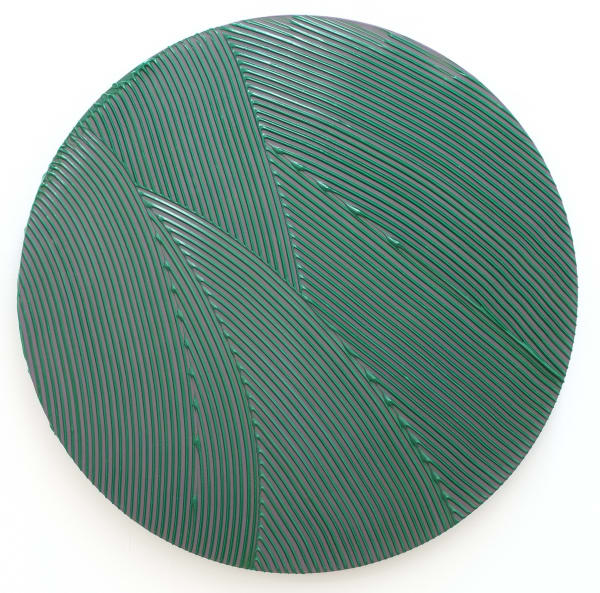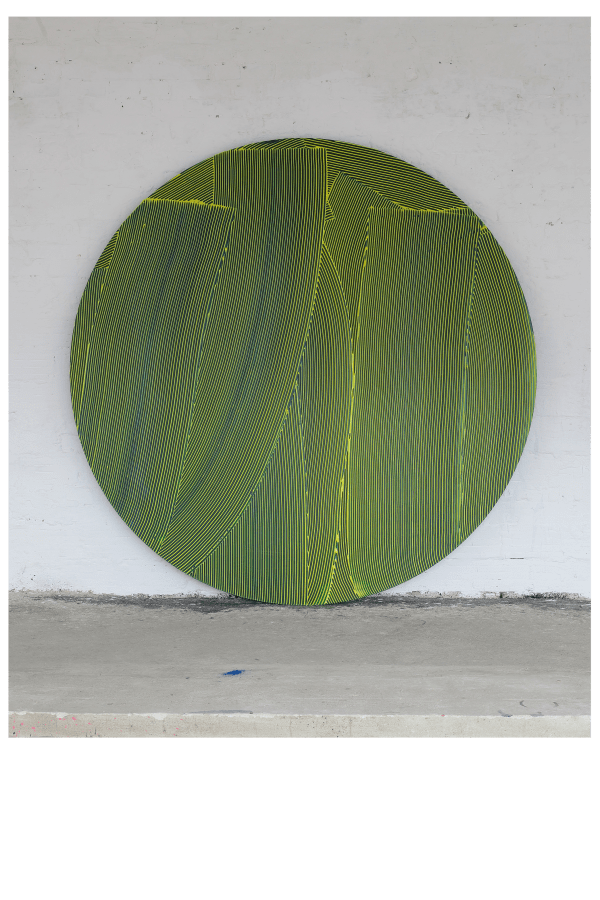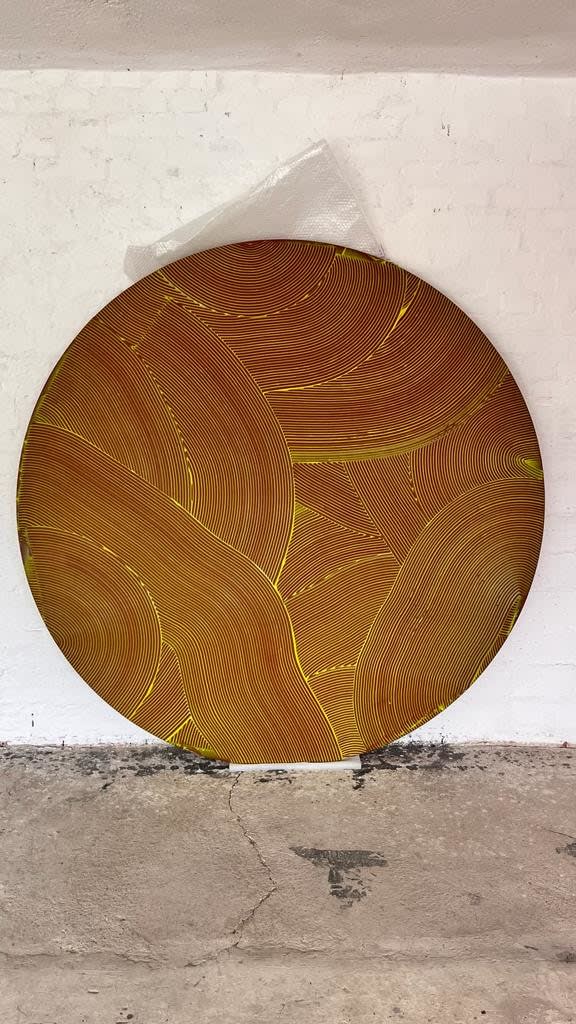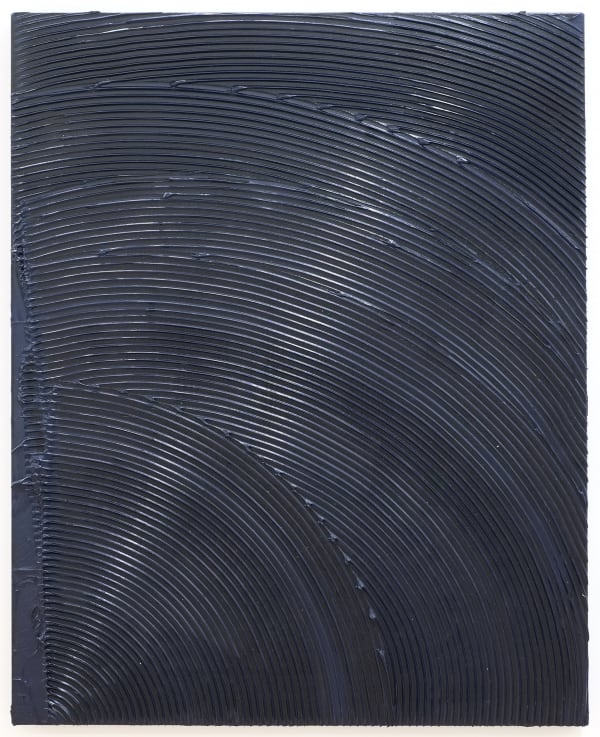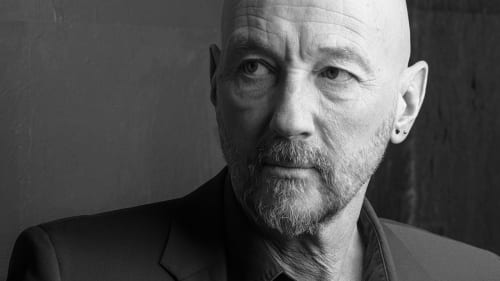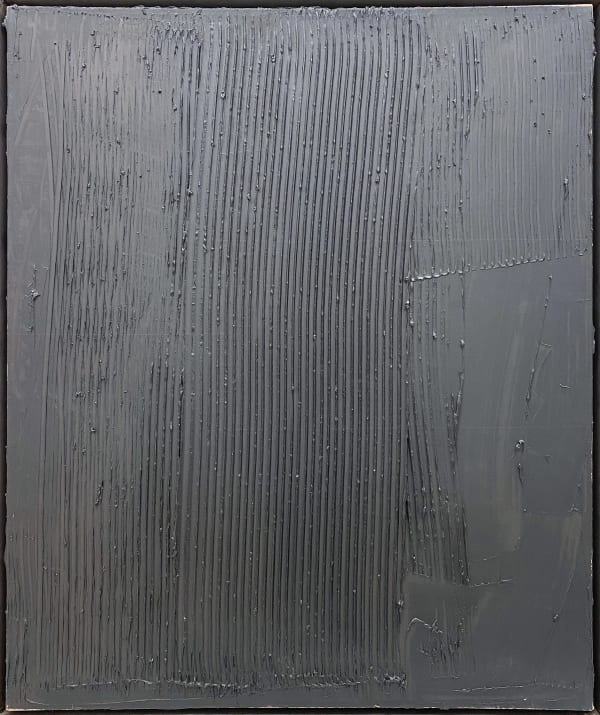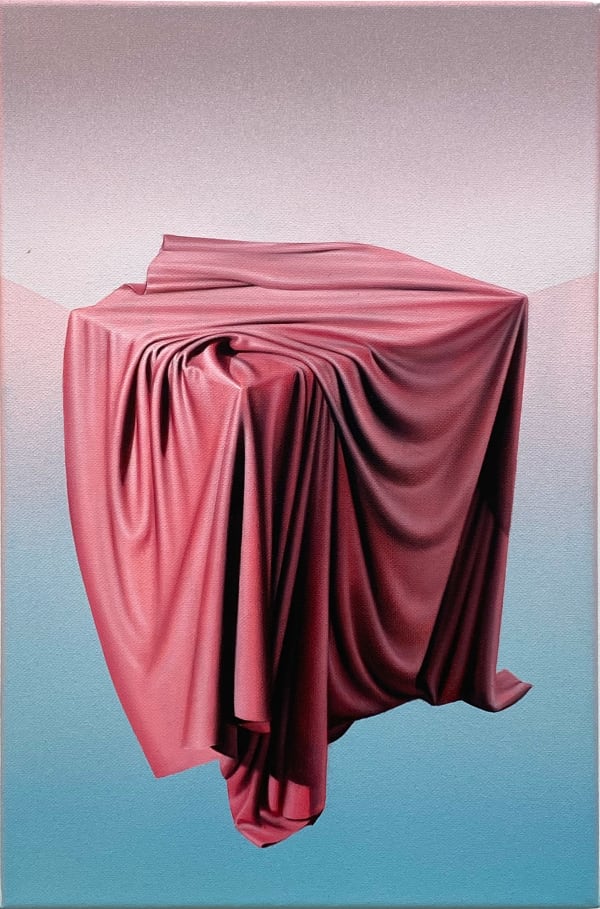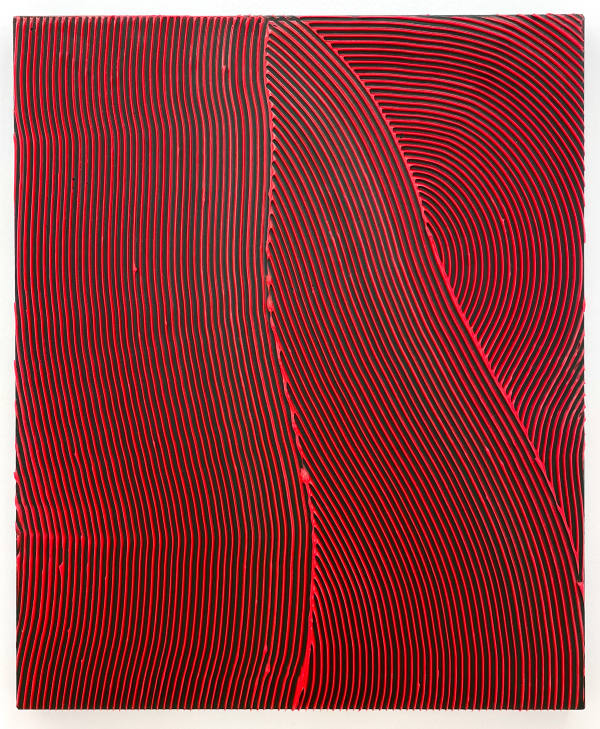"The comb spatulas I use are an anonymous tool, they enable me to work without a 'personal signature'."
In preparation, Jakob Gasteiger applies his paint thickly to the horizontal support and then, with the help of a cardboard comb spatula he made himself, removes this paint from the canvas; only where the comb has its indentations does the paint remain.
This approach, as well as the result of the paintings, illuminates a conceptual-minimalist aspect of painting. The colour is not applied gesturally, expressively and supposedly with the recognisable handwriting on the picture support, no, it is taken away in an anonymous mechanical act of painting, the gesture takes place solely in the movement of the comb and does not allow the painter to be recognised in his expression behind it.
And yet the resulting works are more than pure painting. They are border crossers between panel painting, sculpture and relief. When Gasteiger repeatedly mixes conventional materials of sculpture (iron, glass, aluminium) into his colours, he brings the genres into a coherent connection of his own. It is an experimental approach to form, colour, space and material. This expansion of the concept of painting can certainly be described as conceptual asceticism.
Jakob Gasteiger lives and works in Vienna and in the “wine quarter”, the so called “Weinviertel”, the area below the Manhartsberg (the mountain of Manhart), located in the northeast of Lower Austria
born 1953 in Salzburg, Austria
1970-1974 University of Music and Performing Arts, City of Salzburg
1990 Faistauer Prize for Painting of the Federal State of Salzburg
1995 Prize winner of the 24th Austrian Graphics Competition Innsbruck
1999 Prize of the State Capital Innsbruck at the 26th Austrian Graphics Competition
2017 Recognition Award for Fine Arts of the Federal State of Lower Austria
2019 Great Badge of Honor for Services to the Federal State of Lower Austria
Text of the catalogue for the Venice Biennial Arts Festival 2013 (by F. Steininger):
“As solitary position in the nineteen-eighties, Jakob Gasteiger dissociated himself from the general canon of Neo-Expressionism by casting out onto a minimalist, abstract path in his painting. Monochromism played a major role here, colour as opaque structure of the picture surface, painting as process, aloof from the emotional and personal gesture. These attributes can also be found in the protagonists of radical painting, first and foremost Marcia Hafif, Günter Umberg and Joseph Marioni, who press painting into service as analytical practice. English has two differentiated words for the German word “Farbe”: colour (as optical value) and paint (as tactile value). The pictures of these artists are caught up in this interplay. What they also have in common is a stillness and emptiness, a rejection of pictorial information and expression of the artist as creator. Just as central is the factual and objective reality of the artwork, an artificially created thing among other things, and not a mediator of content, of illusionary or metaphysical information.
The decisive impetus is always the handcrafted type of work invested in the painting: Jakob Gasteiger’s gestural idiom restricts or concentrates itself mostly on drawing the comb through the previously applied paint paste, so that an anonymous, mechanical method predominates. The individual touch seems to be pushed fully into the background. Seen from this classical perspective – as Rembrandt or de Kooning use the brush, for instance – the concept of painting is difficult to apply to Gasteiger, despite all painterly qualities and effects visible on the picture plane. Perhaps it might be better to talk of “making” or “producing” pictures, without excluding the personal impetus, the physical effort of the artist during the work process. The tracing of the comb is evident in the end product, the trail is visible. Sometime Gasteiger integrates dynamics and verve into his pictures by using his instrument to delineate arcs and circle formations in the paint paste. The body’s entire effort is inscribed in the work as it encounters the tough resistance of the previously applied pastose paint layer.”
-

Jakob Gasteiger
Öl auf Papier 5 Apr - 7 Jun 2025 bechter kastowsky gallery. SchaanWorks from the new series that have never been shown before will be exhibited in Liechtenstein.Read more -

SPEKTRUM WIEN
Gruppenausstellung 5 Sep - 31 Oct 2024 bechter kastowsky gallery. ViennaWe are starting the exhibition fall 2024 with a group exhibition!Read more -

SPEKTRUM FL
Gruppenausstellung 31 Aug - 2 Nov 2024 bechter kastowsky gallery. SchaanThe bechter kastowsky gallery is showing a selective choice of works by its artists at its location in Schaan. The exhibition “SPEKTRUM FL” creates a link between past and future...Read more -

Sommer 2024
Mario Dilitz versus Malerei 13 Jul - 24 Aug 2024 bechter kastowsky gallery. SchaanWe are changing Mario Dilitz's previous exhibition: we are assigning paintings to individual sculptures and thus complementing the three-dimensional figure with the two-dimensional image.Read more -

Welcome 2024
27 Jan - 24 Feb 2024 bechter kastowsky gallery. Schaan27 January till 24 Fabruary 2024Read more -

Jakob Gasteiger
4 Nov 2023 - 20 Jan 2024 bechter kastowsky gallery. SchaanOpening: Saturday, November 4, 10 am - 2 pm, opening brunch Openingspeech: 10.30 am, Eva-Maria Bechter '(It is) not so rare in contemporary art, (the) figure of the circular disk,...Read more -

10 years bechter kastowsky gallery!
Mario Dilitz / Jakob Gasteiger / Aurelia Gratzer / Karen Holländer / Petar Mirkovic / Klaus Mosettig / Ahmet Oran / Drago Persic / Hanna Roeckle / Hubert Scheibl / Christoph Schirmer / Martin Schnur / Anneliese Schrenk / Liliane Tomasko 10 Sep - 29 Oct 2022 bechter kastowsky gallery. ViennaRead more -

Summer 2022
Karen Holländer. Liliane Tomasko. Hubert Scheibl. Jakob Gasteiger 13 Jul - 13 Aug 2022 bechter kastowsky gallery. SchaanRead more -

THREE
Mario Dilitz. Jakob Gasteiger. Martin Schnur 17 Mar - 7 May 2022 bechter kastowsky gallery. SchaanRead more -

Jakob Gasteier
Bilder 1985-1990 14 Jan - 5 Mar 2022 bechter kastowsky gallery. ViennaRead more -

Summer 21
Martin Schnur. Drago Persic. Ahmet Oran. Conrad Jon Godly. Jakob Gasteiger 7 Jul - 21 Aug 2021 bechter kastowsky gallery. SchaanRead more -

Jakob Gasteiger
10 Mar - 17 Apr 2021 bechter kastowsky gallery. SchaanRead more -

Jakob Gasteiger / Wiebke Kapitzky
23 Apr - 6 Jun 2015 bechter kastowsky gallery. ViennaVariationen eines Themas werden immer wieder aufgegriffen und verarbeitet. So legt Jakob Gasteiger seinen Kartongrund auf den Boden, um dann in einer gestisch tänzerischen Bewegung – in Jackson Pollocks Tradition...Read more -

Material
Manfred Erjautz. Jakob Gasteiger. Roman Pfeffer. Wendelin Pressl. Anneliese Schrenk. Philipp Schweiger 17 Jan - 2 Mar 2013 bechter kastowsky gallery. ViennaManfred Erjautz , for example, expands his concept of sculpture by creating his works with the help of the children's toy Lego. The archetype of his Lego work is a...Read more
-
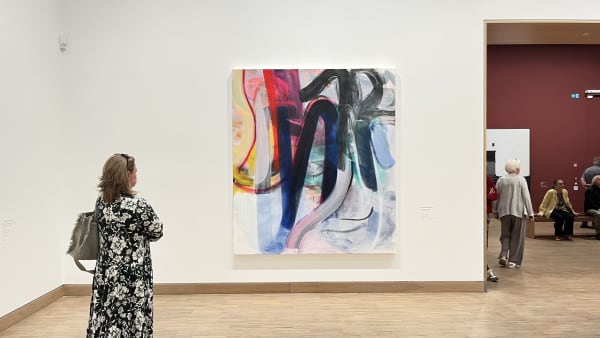
Albertina modern. Austria-Germany
Painting 1970 to 2020 6 Sep 2023 - 21 Jan 2024The relationship between Austria and Germany is different in the visual arts than in sports: there is no competition, no winners and losers. In a...Read more -
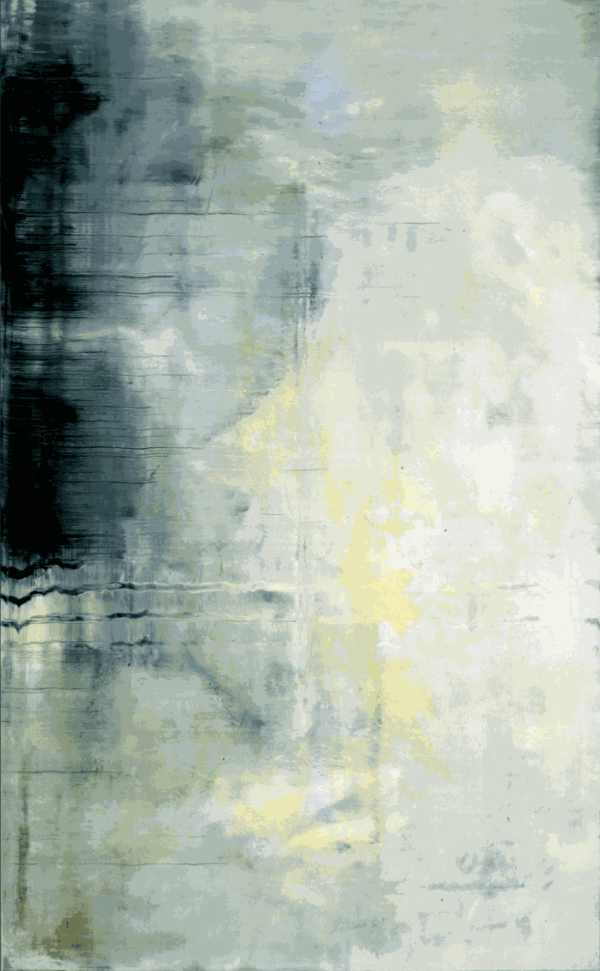
Colossal. Painting On A Grand Scale. Lower Belvedere. Vienna
with works by Hubert Scheibl, Hermann Nitsch, Jakob Gasteiger, Herbert Brandl and others 22 Jun - 27 Aug 2023It requires confidence, skill, imagination, and courage for an artist to tackle a huge canvas. The results are mostly major works of art: impressive, spectacular...Read more -
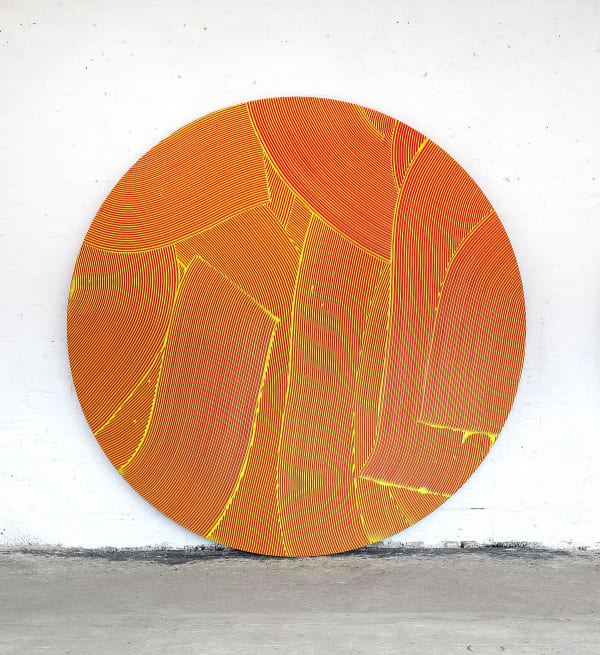
Jakob Gasteiger. Post Radical Painting
Albertina Vienna 23 Apr - 22 Aug 2021The exhibition at the ALBERTINA shows Jakob Gasteiger 's oeuvre from all previous creative periods. The Austrian's work is characterised by a special reflection on...Read more
-
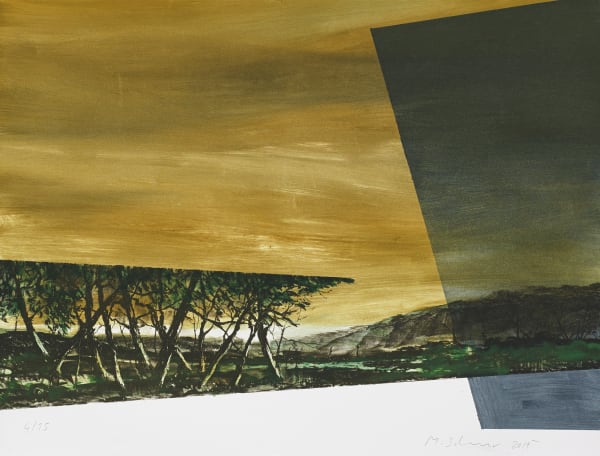
PARALLEL EDITIONS 2023
Martin Schnur. Arnulf Rainer. David Moises. Roy Lichtenstein. IRWIN. Conrad Jon Godly. Jakob Gasteiger 11 - 14 May 2023PARALLEL EDITIONS 2023Read more -
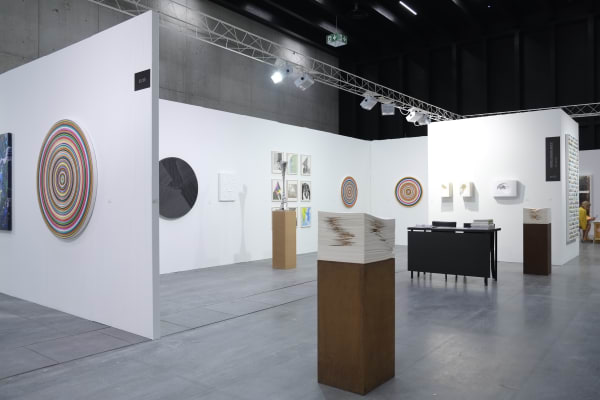
ART BODENSEE 2017
Gasteiger. Glajcar. Patkowitsch. Peters. Scheibl. Willing. Yalcindag 21 - 23 Jul 2017Gasteiger. Glajcar. Patkowitsch. Peters. Scheibl. Willing. YalcindagRead more -

ART BODENSEE 2016
Schrenk. Gasteiger. Holländer 8 - 10 Jul 2016Schrenk. Gasteiger. HolländerRead more



